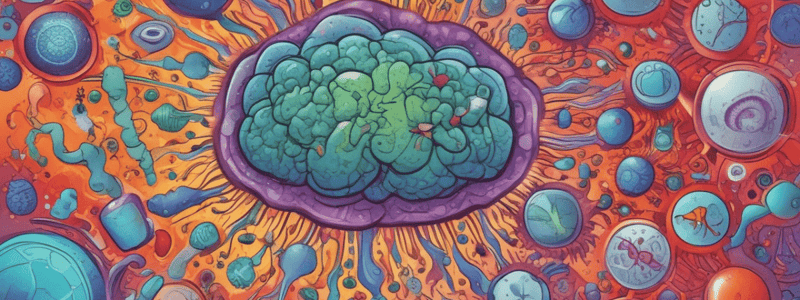Podcast
Questions and Answers
What is the result of covalent binding between a toxicant and a target molecule?
What is the result of covalent binding between a toxicant and a target molecule?
- Electron transfer occurs
- A reversible bond is formed
- A toxicant-target molecule is termed an adduct (correct)
- Hydrogen abstraction occurs
What type of compounds are abundant in biological systems and can participate in covalent binding?
What type of compounds are abundant in biological systems and can participate in covalent binding?
- Electrophilic compounds
- Reactive oxygen species
- Xenobiotics
- Nucleophilic compounds (correct)
What is a potential consequence of covalent binding of toxicants to cellular proteins?
What is a potential consequence of covalent binding of toxicants to cellular proteins?
- Stimulation of enzyme reactions
- Inhibition of vital enzyme reactions (correct)
- Alteration of protein structure
- All of the above
What is the term for the original substance to which the host was exposed?
What is the term for the original substance to which the host was exposed?
Which type of interaction involves the transfer of electrons between a toxicant and its target molecule?
Which type of interaction involves the transfer of electrons between a toxicant and its target molecule?
What is the result of the reaction between an electrophilic compound and a nucleophilic compound?
What is the result of the reaction between an electrophilic compound and a nucleophilic compound?
What is the consequence of covalent binding of toxicants to nucleic acids?
What is the consequence of covalent binding of toxicants to nucleic acids?
Which molecules are frequently involved in toxicity due to their exposure to reactive chemicals?
Which molecules are frequently involved in toxicity due to their exposure to reactive chemicals?
What is the first target for reactive metabolites?
What is the first target for reactive metabolites?
What is required for a toxicant to react with a target molecule?
What is required for a toxicant to react with a target molecule?
What is the effect of some toxicants on protein target molecules?
What is the effect of some toxicants on protein target molecules?
What is the result of bifunctional electrophiles reacting with cytoskeletal proteins, DNA, or DNA with proteins?
What is the result of bifunctional electrophiles reacting with cytoskeletal proteins, DNA, or DNA with proteins?
What is the consequence of radicals converting proteins into reactive electrophiles?
What is the consequence of radicals converting proteins into reactive electrophiles?
What is necessary to conclusively identify a target molecule as being responsible for toxicity?
What is necessary to conclusively identify a target molecule as being responsible for toxicity?
What is the effect of tetrodotoxin and saxitoxin on the neuronal membrane?
What is the effect of tetrodotoxin and saxitoxin on the neuronal membrane?
What is the result of toxicants binding to tubulin or actin?
What is the result of toxicants binding to tubulin or actin?
What is the result of receptor activation in cells?
What is the result of receptor activation in cells?
What is the common modality of dysregulation of transcription?
What is the common modality of dysregulation of transcription?
What is the result of xenobiotics facilitating phosphorylation of signal transduction proteins?
What is the result of xenobiotics facilitating phosphorylation of signal transduction proteins?
What is the effect of phorbol esters on protein kinase C (PKC)?
What is the effect of phorbol esters on protein kinase C (PKC)?
What is the result of Pb2+ on protein kinase C (PKC)?
What is the result of Pb2+ on protein kinase C (PKC)?
What is the effect of activated PKC on mitogenic signaling?
What is the effect of activated PKC on mitogenic signaling?
What can be the result of xenobiotics influencing cellular activity in excitable cells?
What can be the result of xenobiotics influencing cellular activity in excitable cells?
What can be the final endpoint of cellular or biochemical toxicity?
What can be the final endpoint of cellular or biochemical toxicity?
What is the effect of cross-linking on target molecules?
What is the effect of cross-linking on target molecules?
What can be the result of chemicals interfering with signal transduction?
What can be the result of chemicals interfering with signal transduction?
What is the result of severe cell damage?
What is the result of severe cell damage?
What is the main difference between necrosis and apoptosis?
What is the main difference between necrosis and apoptosis?
What is the result of a reduced production of cellular proteins in necrosis?
What is the result of a reduced production of cellular proteins in necrosis?
What is the term for the accumulation of lipids in the cytoplasmic vacuoles in necrosis?
What is the term for the accumulation of lipids in the cytoplasmic vacuoles in necrosis?
What is the normal process in which cells have a finite lifespan and spontaneously die?
What is the normal process in which cells have a finite lifespan and spontaneously die?
What is the term for the fragments of cells that undergo apoptosis?
What is the term for the fragments of cells that undergo apoptosis?
What is the result of dysfunction of cell maintenance?
What is the result of dysfunction of cell maintenance?
What is the energy currency of the cell?
What is the energy currency of the cell?
What is the result of impairment of oxidative phosphorylation?
What is the result of impairment of oxidative phosphorylation?
What is the process that couples oxidation of hydrogen to water in the mitochondria?
What is the process that couples oxidation of hydrogen to water in the mitochondria?
What is the primary organ responsible for excreting metals from the body?
What is the primary organ responsible for excreting metals from the body?
Which metal is known to be a potent nephrotoxicant?
Which metal is known to be a potent nephrotoxicant?
What is the effect of methylmercury on the nervous system?
What is the effect of methylmercury on the nervous system?
What is the result of xenobiotics binding to hormone receptors?
What is the result of xenobiotics binding to hormone receptors?
Which estrogen receptor agonist is known to cause gynecomastia?
Which estrogen receptor agonist is known to cause gynecomastia?
What is the effect of chronic exposure to metal dust on the respiratory system?
What is the effect of chronic exposure to metal dust on the respiratory system?
What is the function of metal-binding proteins in the cell?
What is the function of metal-binding proteins in the cell?
Which type of metal compound is more likely to enter the nervous system?
Which type of metal compound is more likely to enter the nervous system?
What is the result of metal inclusion bodies forming in the nucleus?
What is the result of metal inclusion bodies forming in the nucleus?
Which of the following metals is a known human carcinogen?
Which of the following metals is a known human carcinogen?
What is the primary function of metallothionein (MT) in the body?
What is the primary function of metallothionein (MT) in the body?
What is the mode of action of carbamate and organophosphate insecticides?
What is the mode of action of carbamate and organophosphate insecticides?
What is the effect of acetylcholinesterase inhibition on nerve or muscle stimulation?
What is the effect of acetylcholinesterase inhibition on nerve or muscle stimulation?
What is the typical duration of acetylcholinesterase inhibition?
What is the typical duration of acetylcholinesterase inhibition?
What is the primary cause of death in cases of cholinesterase inhibition?
What is the primary cause of death in cases of cholinesterase inhibition?
What is the mechanism of action of neonicotinoid insecticides?
What is the mechanism of action of neonicotinoid insecticides?
What is the function of acetylcholinesterase in the nervous system?
What is the function of acetylcholinesterase in the nervous system?
What is the effect of pyrethrin and pyrethroid binding to sodium channels?
What is the effect of pyrethrin and pyrethroid binding to sodium channels?
What is the mechanism of action of avermectins?
What is the mechanism of action of avermectins?
What is the primary function of Na+K+ ATPases in nerve impulse transmission?
What is the primary function of Na+K+ ATPases in nerve impulse transmission?
What is the mechanism of action of chemicals in class D?
What is the mechanism of action of chemicals in class D?
What is the effect of sustained elevation of intracellular Ca2+?
What is the effect of sustained elevation of intracellular Ca2+?
How do metals exert their toxicity?
How do metals exert their toxicity?
What is the major site of toxic action for metals?
What is the major site of toxic action for metals?
How can metals inhibit enzymes?
How can metals inhibit enzymes?
What is the result of lead displacing zinc in the enzyme δ-aminolevulinic acid dehydratase (ALAD)?
What is the result of lead displacing zinc in the enzyme δ-aminolevulinic acid dehydratase (ALAD)?
What is the effect of Ca2+ on the citric acid cycle?
What is the effect of Ca2+ on the citric acid cycle?
What is the result of Ca2+ activating nitric oxide synthase?
What is the result of Ca2+ activating nitric oxide synthase?
What is the effect of xenobiotics on intracellular Ca2+ levels?
What is the effect of xenobiotics on intracellular Ca2+ levels?
What is the effect of toxic metals on subcellular organelles?
What is the effect of toxic metals on subcellular organelles?
What is the primary mechanism of neurotoxicity of DDT?
What is the primary mechanism of neurotoxicity of DDT?
Which type of receptors are associated with chloride channels on the postsynaptic region of the neuron?
Which type of receptors are associated with chloride channels on the postsynaptic region of the neuron?
What is the effect of GABAA receptor inhibition on nerve excitation?
What is the effect of GABAA receptor inhibition on nerve excitation?
Which insecticides elicit acute neurotoxicity by inhibiting the GABAA receptor?
Which insecticides elicit acute neurotoxicity by inhibiting the GABAA receptor?
What is the primary mechanism of action of avermectins?
What is the primary mechanism of action of avermectins?
Which compounds enhance the ability of gamma-aminobutyric acid to bind the GABAA receptor?
Which compounds enhance the ability of gamma-aminobutyric acid to bind the GABAA receptor?
What is the process by which energy is generated in the cell while molecular oxygen is consumed?
What is the process by which energy is generated in the cell while molecular oxygen is consumed?
Where does the process of cellular respiration occur?
Where does the process of cellular respiration occur?
What is the effect of rotenone on cellular respiration?
What is the effect of rotenone on cellular respiration?
What is a common symptom of toxicity resulting from the inhibition of cellular respiration?
What is a common symptom of toxicity resulting from the inhibition of cellular respiration?
Flashcards are hidden until you start studying





